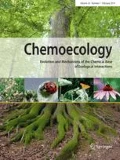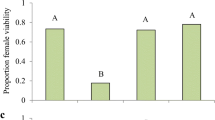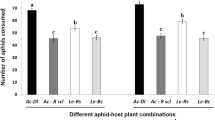Abstract
Little is known about how plant nutritional and defensive qualities interact to influence predator–prey interactions. To address this need, we provided the neo-tropical milkweed, Asclepias curassavica, with two levels of nitrogen availability and examined how altered host-plant quality influenced the responses of a specialist aphid, Aphis nerii, and a coccinellid predator, Harmonia axyridis. Aphis nerii uses A. curassavica for multiple resources, including nutrition and sequestration of cardenolides for defense against natural enemies. Increased nitrogen availability improved A. curassavica quality by decreasing carbon-to-nitrogen (C:N) ratios and cardenolide concentrations, resulting in A. nerii that also had lower C:N ratios and cardenolide concentrations. Aphis nerii population growth was higher on plants with high nitrogen availability, compared with aphids on plants with low nitrogen availability. In no-choice feeding trials, Harmonia axyridis consumed more high C:N ratio aphids, suggesting a potential compensatory response to reduced aphid nutritional quality. Additionally, H. axyridis were able to consume more low-quality aphids at the expense of increasing exposure to increased cardenolide concentrations, suggesting that interactions between H. axyridis and A. nerii may be strongly influenced by prey nutritional quality. This work highlights the need to consider how variation in plant quality influences herbivore nutritional and defensive quality when examining mechanisms that influence predator–prey interactions.



Similar content being viewed by others
References
Agrawal AA (2004) Plant defense and density dependence in the population growth of herbivores. Am Nat 164:113–120
Agrawal AA (2005) Natural selection on a common milkweed (Asclepias syrica) by a community of specialized insect herbivores. Evol Ecol Res 7:651–667
Awmack CS, Leather SR (2002) Host plant quality and fecundity in herbivorous insects. Annu Rev Entomol 47:817–844
Baldwin IT (1989) Mechanism of damaged-induced alkaloid production in wild tobacco. J Chem Ecol 15:1661–1680
Botha CEJ, Malcolm SB, Evert RF (1977) An investigation of preferential feeding habit in four Asclepiadaceae by the aphid, Aphis nerii B. de F. Protoplasma 92:1–19
Brower LP, Ryerson WN, Coppinger LL, Glazier SC (1968) Ecological chemistry and the palatability spectrum. Science 27:1349–1350
Brower LP, McEvoy PB, Williamson KL, Flannery MA (1972) Variation in cardiac glycoside content of monarch butterflies from natural populations in Eastern North America. Science 177:426–429
Cha DH, Hochwender CG, Bosecker EM, Tucker RE, Kaufman AD, Fritz RS, Smyth RR (2009) Do exotic generalist predators alter host plant preference of a native willow beetle? Agric For Entomol 11:175–184
Chen F, Ge F, Parajulee MN (2005) Impact of elevated CO2 on tri-trophic interaction of Gossypium hirsutum, Aphis gossypii, and Leis axyridis. Environ Entomol 34:37–46
Chen Y, Olson DM, Ruberson JR (2010) Effects of nitrogen fertilization on tritrophic interactions. Arthropod Plant Interact 4:81–94
Cheng L (1970) Timing of attack by Lypha dubia Fall. (Diptera: Tachinidae) on the winter moth, Operophthera brumata (Lepidoptera: Geometridae) as a factor affecting parasite success. J Anim Ecol 39:313–320
Coley PD, Bateman ML, Kursar TA (2006) The effects of plant quality on caterpillar growth and defense against natural enemies. Oikos 115:219–228
Denno RF, Fagan WF (2003) Might nitrogen limitation promote omnivory among carnivorous arthropods? Ecology 84:2522–2531
Fagan WF, Siemann E, Mitter C, Denno RF, Huberty AF, Woods HA, Elser JJ (2002) Nitrogen in insects: implications for trophic complexity and species diversity. Am Nat 160:784–802
Gratton C, Denno RF (2003) Seasonal shift from bottom-up to top-down impact in phytophagous insect populations. Oecologia 134:487–495
Harvey JA, Van Dam NM, Gols R (2003) Interactions over four trophic levels: foodplant quality affects development of a hyperparasitoid as mediated through a herbivore and its primary parasitoid. J Anim Ecol 72:520–531
Holton MK, Lindroth RL, Nordheim EV (2003) Foliar quality influences tree-herbivore-parasitoid interactions: effects of elevated CO2 and O3. Oecologia 137:233–244
Hugentobler UJ, Renwick AA (1995) Effects of plant nutrition on the balance on insect relevant cardenolides and glucosinolates in Erysimum cheiranthoides. Oecologia 102:95–101
Hunter MD (2003) Effects of plant quality on the population ecology of parasitoids. Agric For Entomol 5:1–8
Hunter MD, Price PW (1992) Playing chutes and ladders: heterogeneity and the relative roles of bottom-up and top-down forces in natural communities. Ecology 73:724–732
Kagata H, Ohgushi T (2007) Carbon-nitrogen stoichiometry in the tritrophic food chain willow, leaf beetle, and predatory ladybird beetle. Ecol Res 22:671–677
Kagata H, Nakamura M, Ohgushi T (2005) Bottom-up cascade in a tri-trophic system: different impacts of host-plant regeneration on performance of a willow leaf beetle and its natural enemy. Ecol Entomol 30:58–62
Karban R, Baldwin IT (1997) Induced responses to herbivory. University of Chicago Press, Chicago
Karowe DN, Schoonhoven LM (1992) Interactions among three trophic levels: the influence of host plant on performance of Pieris brassicae and its parasitoid, Cotesia glomerata. Entomol Exp Appl 61:241–251
Kytö M, Niemela P, Larrson S (1996) Insects on trees: population and individual responses to fertilization. Oikos 75:148–159
Lavoie B, Oberhauser KS (2004) Compensatory feeding in Danaus plexippus (Lepidoptera: Nymphalidae) in response to variation in host plant quality. Environ Entomol 33:1062–1069
Malcolm SB (1981) Defensive use of plant-derived cardenolides by Aphis nerii Boyer de Fonscolombe against predation. Dissertation, University of Oxford, Oxford
Malcolm SB (1986) Aposematism in a soft-bodied insect: a case for kin selection. Behav Ecol Sociobiol 18:387–393
Malcolm SB (1989) Disruption of web structure and predatory behavior of a spider by plant-derived chemical defenses of an aposematic aphid. J Chem Ecol 15:1699–1716
Malcolm SB (1990) Chemical defense in chewing and sucking herbivores: plant derived cardenolides in the monarch butterfly and the oleander aphid. Chemoecology 1:12–21
Malcolm SB (1991) Cardenolide-mediated interactions between plants and herbivores. In: Rosenthal GA, Berenbaum MR (eds) Herbivores: their interactions with secondary plant metabolites, 2nd edn, Volume I: The Chemical Participants. Academic Press, San Diego, pp 251–296
Malcolm SB (1992) Prey defense and predator foraging. In: Crawley MJ (ed) Natural enemies. The population biology of predators, parasites, and disease. Blackwell, Oxford, pp 458–475
Mattson WJ (1980) Herbivory in relation to plant nitrogen content. Annu Rev Ecol Syst 11:119–161
Mayntz D, Toft S (2001) Nitrogen composition of the prey’s diet affects growth and survivorship of a generalist predator. Oecologia 127:213
Mooney KA, Halitschke R, Kessler A, Agrawal AA (2010) Evolutionary trade-offs in plants mediate the strength of trophic cascades. Science 327:1642–1644
Müller MS, McWilliams SR, Podlesak D, Donaldson JR, Bothwell HM, Lindroth RL (2006) Tri-trophic effects of plant defenses: chickadees consume caterpillars based on host leaf chemistry. Oecologia 114:507–517
Nelson CJ (1993) Sequestration and storage of cardenolides and cardenolide glycosides by Danaus plexippus and D. chrysippus petila when reared on Asclepias fruticosa: with a review of some factors that influence sequestration. In: Malcolm SB, Zalucki, MP (eds) Biology and conservation of the monarch butterfly. Natural History Museum of Los Angeles County, Los Angeles, California, USA, pp 83–90
Pasteels JM (1978) Apterous and brachypterous coccinellids at the end of the food chain, Cionura erecta (Asclepiadaceae) Aphis nerii. Entomol Exp Appl 24:579–584
Pasteels JM, Rowell-Rahier M, Braekman JC, Dupont A (1983) Salicin from host plant as precursor of salicylaldehyde in defensive secretions of Chrysomeline larvae. Physiol Entomol 8:307–314
Pasteels JM, Braekman J-C, Daloze D (1988) Chemical defense in the Chrysomelidae. In: Jolivet P, Petitpierre E, Hsiao TH (eds) Biology of the Chrysomelidae. Kluwer, Dordrecht, pp 233–252
Price PW, Bouton CE, Gross P, McPheron BA, Thompson JN, Weis AE (1980) Interactions among three trophic levels: influence of plants on interactions between insect herbivores and natural enemies. Annu Rev Ecol Syst 11:41–65
Rank NE (1994) Host-plant effects on larval survival of a salicin-using leaf beetle Chrysomela aeneicollis Schaeffer (Coleoptera: Chrysomelidae). Oecologia 97:342–353
Rasmann S, Agrawal AA, Erwin AC, Cook SC (2009) Cardenolides, induced responses, and interactions between above and belowground herbivores in the milkweeds (Asclepias spp.). Ecology 90:2393–2404
Rosenthal GA, Berenbaum MR (1991) Herbivores: their interaction with secondary plant metabolites. Academic Press, New York
Rothschild M, von Ewu J, Reichstein T (1970) Cardiac glycosides in the oleander aphid Aphis nerii. J Insect Physiol 16:1191–1195
Snyder WE, Joesph SB, Preziosi RF, Moore AJ (2000) Nutritional benefits of cannibalism for the lady beetle Harmonia axyridis (Coleoptera: Coccinellidae) when prey quality is poor. Environ Entomol 29:1173–1179
Teder T, Tammaru T (2002) Cascading effects of variation in plant vigour on the relative performance of insect herbivores and their parasitoids. Ecol Entomol 27:94–104
Throop HL (2005) Nitrogen deposition and herbivory affect biomass production and allocation in an annual plant. Oikos 111:91–100
Throop HL, Lerdau MT (2004) Effects of nitrogen deposition on insect herbivory: implications for community and ecosystem processes. Ecosystems 7:109–133
Zalucki MP, Brower LP (1992) Survival of first instar larvae Danaus plexippus (Lepidoptera: Danainae) in relation to cardiac glycoside and latex content of Asclepias humistrata (Asclepiadaceae). Chemoecology 3:81–93
Zalucki MP, Malcolm SB (1999) Plant latex and first-instar monarch larval growth and survival on three North American milkweed species. J Chem Ecol 8:1827–1842
Zalucki MP, Malcolm SB, Paine TD, Hanlon CC, Brower LP, Clarke AR (2001) It’s the first bite that counts: survival of first-instar monarchs on milkweeds. Austral Ecol 26:1–9
Zhender C, Hunter M (2008) Effects of nitrogen deposition on the interaction between an aphid and its host plant. Ecol Entomol 33:24–30
Acknowledgments
We are grateful to S. B. Malcolm for supplying A. curassavica, A. nerii, and TNDP for cardenolide analysis. We would also like to thank L. M. Holeski, K. Keefover-Ring, K. F. Rubert, M. L. Hillstrom, C. H. Habeck, and C. Buhl for comments on the manuscript. This work was supported by U.S. Department of Energy (Office of Science, BER) grant DE-FG02-06ER64232.
Author information
Authors and Affiliations
Corresponding author
Rights and permissions
About this article
Cite this article
Couture, J.J., Servi, J.S. & Lindroth, R.L. Increased nitrogen availability influences predator–prey interactions by altering host-plant quality. Chemoecology 20, 277–284 (2010). https://doi.org/10.1007/s00049-010-0058-y
Received:
Accepted:
Published:
Issue Date:
DOI: https://doi.org/10.1007/s00049-010-0058-y




